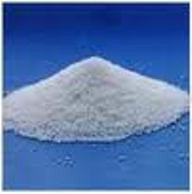SODIUM LAURYL SULPHATE 92% (SLS)
Sodium dodecyl sulfate (SDS)
Sodium lauryl sulfate (SLS) is a widely used surfactant, which means it has the ability to reduce the surface tension of water, helping to create foam and allowing oils and dirt to mix with water so they can be rinsed away.
Chemical Composition:
- Chemical Formula: C₁₂H₂₅NaO₄S
- Structure: SLS is an organic compound made up of a 12-14 carbon long chain (derived from lauric acid, which is found in coconut and palm oils) attached to a sulfate group (SO₄²⁻), with a sodium ion (Na⁺) to balance the charge.
Common Uses:
-
Personal Care Products:
- SLS is found in many personal care products like shampoos, bubble baths, body washes, and facial cleansers. It’s responsible for the foaming action that helps these products clean effectively.
-
Household Cleaning Products:
- It’s also a common ingredient in household cleaning products such as detergents, dish soaps, and laundry detergents due to its ability to break down grease and dirt.
-
Industrial Applications:
- In industrial settings, SLS is used in various applications including as a detergent in textile and leather processing, as an emulsifier in insecticides, and as a foaming agent in some industrial cleaners.
Properties:
- Foaming Agent: SLS is prized for its ability to create a rich lather, which is why it’s included in many cleaning and personal care products.
- Detergent Action: It is an effective detergent, meaning it can remove oils and dirt from surfaces, including skin and hair.
- Emulsification: SLS helps to mix oil and water, stabilizing the mixture so that the product remains effective and homogeneous.
See below for further information on how to use.
Alternatives:
- Sodium Lauryl Sulfoacetate (SLSA): A milder alternative to SLS, often used in natural or hypoallergenic products.
- Sodium Laureth Sulfate (SLES): A related compound that is milder than SLS and is also widely used in personal care products.
Summary:
Sodium lauryl sulfate is a common and effective surfactant used in a wide variety of products for its ability to clean and create foam. While it is generally safe for most people, those with sensitive skin or specific allergies may prefer to use products that are free of SLS or use milder alternatives.
PLEASE NOTE: This product is not for human or animal consumption.
How to Dissolve and Stabilize Sodium Lauryl Sulfate (SLS) in Water
Sodium Lauryl Sulfate (SLS) is an anionic surfactant widely used in detergents, shampoos, and industrial cleaners due to its foaming and cleansing properties. However, dissolving and stabilizing it in water requires proper techniques to prevent clumping, gelling, or precipitation.
1. Selecting the right form of SLS
SLS is available in different forms, which affect solubility and ease of dissolution:
- SLS Powder (90-95% active) → More difficult to dissolve, prone to clumping.
- SLS Needles/Granules (80-90% active) → Easier to dissolve than powder.
- SLS Liquid Solution (28-30% active) → Pre-dissolved, easiest to handle.
If using powder or granules, follow a proper dispersion method.
2. Dissolving SLS in water
Step-bt-step dissolution process
- Use Warm Water (40-50°C)
· SLS dissolves best in warm, but not hot, water.
· Avoid temperatures above 60°C, as excessive heat can cause foaming and degradation.
- Slowly Add SLS to Water (Not the Other Way Around)
· Sprinkle SLS gradually while stirring continuously.
· This prevents clumping and gel formation.
- Use Constant Agitation
· Use a magnetic stirrer, mechanical stirrer, or high-shear mixer for faster dissolution.
· Stirring ensures even dispersion and prevents localized high concentrations.
- Adjust pH (Optional)
· SLS is more stable between pH 6-8.
· If necessary, adjust pH using citric acid (to lower) or sodium hydroxide (to raise).
3. Stabilizing SLS in solution
Once SLS is dissolved, stabilization prevents precipitation or phase separation over time.
Key Stabilization Techniques:
· Increase Water Content - Dilute to at least 10-30% active SLS for stability.
· Add Co-Surfactants like Cocamidopropyl Betaine (CAPB) at 5-10% helps reduce viscosity and improves solubility.
· Add Sodium Chloride (Salt Thickening Method) - At 1-3%, salt helps adjust viscosity but must be added carefully to avoid precipitation.
· Use a Chelating Agent (EDTA, Sodium Citrate) - Prevents instability caused by metal ions.
· Preservation (For Long-Term Storage) - Add 0.1-0.2% preservative (e.g., phenoxyethanol, sodium benzoate) to prevent microbial contamination
4. Suggested Formulation for a Stable SLS Solution (30% Active)
|
Ingredient |
Amount (%) |
|
Sodium Lauryl Sulfate (SLS, Powder or Needles) |
30% |
|
Water (Warm, 40-50°C) |
65% |
|
Cocamidopropyl Betaine (Optional, for stabilization) |
5% |
|
Sodium Chloride (for thickening, optional) |
0.5-1% |
|
EDTA or Sodium Citrate (Chelating Agent) |
0.1% |
|
Preservative (if storing long-term) |
0.1-0.2% |
5. Common Problems & Solutions
|
Issue |
Cause |
Solution |
|
Clumping |
Adding SLS too fast |
Add slowly with constant stirring |
|
Too Thin (Low Viscosity) |
Too much water |
Add salt or CAPB for thickening |
|
Precipitation Over Time |
Poor solubility or wrong pH |
Adjust pH to 6-8, use chelating agents |
|
Excessive Foaming |
Stirring too fast |
Use low-speed mixing |
Conclusion
To dissolve and stabilize SLS in water, use warm water, slow addition, continuous stirring, and co-surfactants like CAPB. For long-term stability, adjust pH, add chelating agents, and control viscosity with salt.
